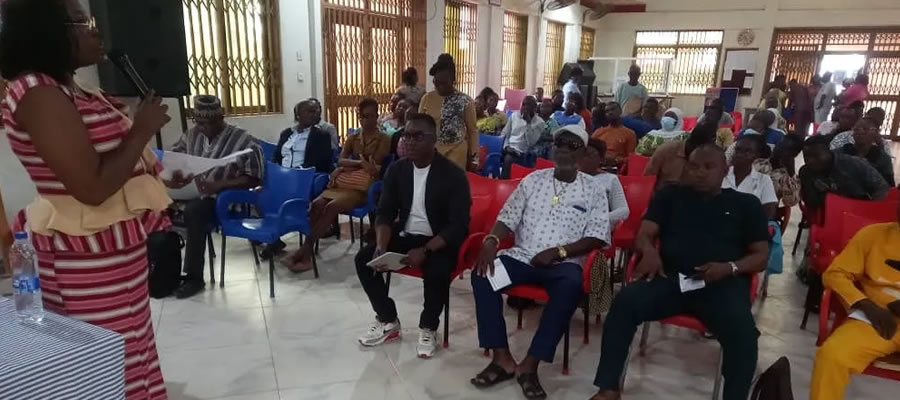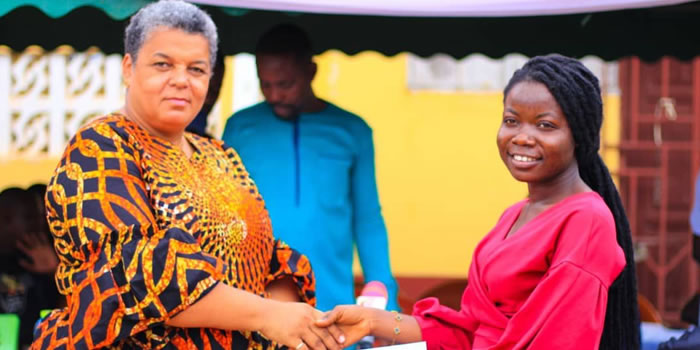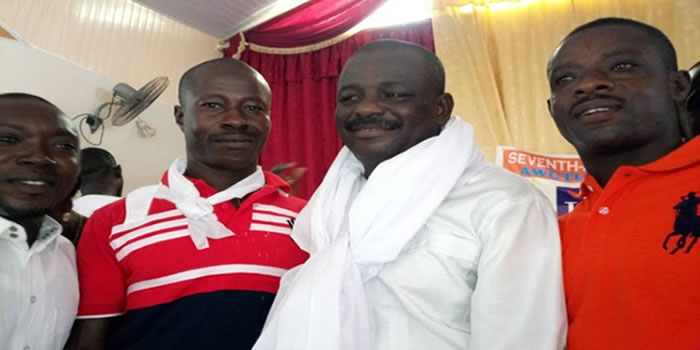

Introduction
The social characteristics of the district’s population influence and are in turn influenced by social and economic development occurring in the district. This chapter examines the social characteristics of the population of Awutu Senya West District in the areas of household characteristics, marital status, nationality, religion, education and literacy.
Household size, composition and headship
The 2010 PHC defines a household as a person or a group of persons, who lived together in the same house or compound and share the same house-keeping arrangements and constitute a single consumption unit. Household members are not necessarily related by blood or marriage because friends and hired domestic workers may also be part of households. The information on households basically includes household size, composition, and headship. The size, structure and composition of households are influenced by social, economic and demographic factors while the total size of a population and its characteristics are in effect largely a reflection of what pertains at the household level (Weeks 2012, Shyrock et al 1976
Household size
The household is the basic unit for demographic and economic analyses. Household size refers to the total number of persons in a household irrespective of age, sex, or relationship status. There are 20,955 households in the District of which 50.7 percent (13,291) are in rural areas with the rest in urban settlements. The average household size for the District is the same as that of the region. While the average household size is slightly higher in rural areas, the number of household per house is lower in rural areas compared to urban areas.
Household composition
Table 3.1 presents the household composition of the Awutu Senya West District. From the table, the district has a household population of 84,505 and 20,955 households. Of the male household population, 31.4 percent are household heads while for the female household population 19.0 percent of them are household heads. The table further shows that more than two fifths (42.6%) of the household members are children of the heads of household, slightly less than one tenth of the members are spouses (9.7%) with parents or parents in law constituting less than one percent of the household population. Adopted/foster children constitute a low 0.03 percent of the household population. The relatively high proportion of grandchildren (10.3%) of the household population reflects a common living arrangement that encourages the grandchildren of the household head and/or spouse to live in the household rather than with their own nuclear families. Other relatives make up 6.4 percent of households.
Household and population structure
The characteristics of any population usually reflect the features of its individual household members within the population. The population size, composition, and structure of households are influenced by socio-economic and demographic factors such as age at first marriage, birth, length of time spent in school, cultural practices, occupation, material or financial abilities, capabilities of parents and couples, fertility and mortality rates, and migration. Knowledge of household structure and composition provide important statistical tool for social and economic planning. A study of households also provides the basis for a reasonable projection of the future size of population and planning of housing needs.
Table 3.3 summaries information about the household population and structure by sex for the
district. Living arrangement is an important aspect of the cultural settings in Ghana. The table shows that 42,063 households are nuclear while 42,442 households are extended. This indicates a slight dominance of extended family households in the District. For the nuclear family households, the majority of households in the district are composed of head, spouse(s) and children (28.9%) followed by single parenthood nuclear household (14.2%). Nearly five percent of households in the district are heads only or single-person households. Households comprising of the head and his or her spouse constitute 1.8 percent of total household population.
Households with single parenthood and extended family members (19.3%) constitute the largest proportion among the extended family category, followed by extended family households consisting of the head, spouse(s), children and head’s relatives (16.8%). Head with other composition but no spouse (9.2%) comes next. In the nuclear family structure, male proportions exceed corresponding female proportions in all four household categories. Nuclear (head, spouse(s) and children) constitute the largest proportion for both male (31.4%) and female (26.7%) households under the nuclear family structure.
Three of the six household categories under the extended family structure have female household proportions more than corresponding male proportions. They are single parent extended, head, spouse(s) and other composition, and single parent extended with non-relatives.
Marital status
Marital status is one of the social characteristics of a population that is determined by biological, social, economic, legal and, in many cases, religious factors. Marriage is socially defined to include formal unions that are legally, traditionally or religiously sanctioned as well as cohabiting unions. Marriage is associated with population dynamics as it affects the processes and levels of fertility and, to a lesser extent, mortality and migration.
Distribution of population by marital status
In 2010, 38.6 percent had never married, 36.9 percent had been married, 12.4 percent are in informal or consensual union, six percent are widowed and 3.9 percent are divorced. Only a relatively small proportion of reported being separated (2.2%).
Marital status by age and sex
As expected the majority (91.4%) of the never married population are adolescents who may still be in school or training. The proportion married increases with age up to age group 45-49 years and then starts to decline for older ages.is more prevalent after age 45-49 years probably as a result of effect duration of marriage. Widowhood is also more common at the older ages, particularly among those 65 years and older (40.8%). Similar pattern is observed for both sexes but widowhood is relatively higher among females compared to males. However, 47.0 percent of the never married are males compared to 31.7 of females.
Marital status and level of education
Table 3.4 provides information on marital status and level of education. Majority of the population 12 years and older who had never married had basic education (75.5%). The lowest proportion of them have either vocational/technical/ commercial (0.7%) or tertiary education (0.7%).
Among those in consensual union/living together 63.8 percent had basic education and 28 percent with no education. 59.3 percent of the married also have basic education and 36.8 percent have no education. The proportion is lowest across all the marital characteristics for persons with tertiary education. Variations in marital status for the sexes follow similar pattern.
Marital status and economic activity status
Activity status of persons provides an indication of ability to marry and support a spouse financially in some cultures in Ghana. Table 3.5 presents information on persons 12 years and older by sex, marital status and economic activity status. It is seen from the table that 65.5 percent are employed, 2.9 percent are unemployed while 31.6 percent are not economically active. Nearly 60 percent of the district’s populations who have never married are economically not active and the female proportion of this category (63.3%) is higher than the corresponding male proportion (57.1%). More than eight in ten of the married persons (86.6%), those in consensual union (89.3%), the separated (84.6%) and the widowed (84.4%) are employed. Similar pattern is observed among the sexes. Unemployment figures for both males and females in all marriage categories are less than 5 percent except for females in informal/consensual union.
Nationality
The nationality of the population of Awutu Senya West District is shown in Table 3.6. Persons of Ghanaian parentage, as expected, constitute the largest percentage of the population (95%) and Ghanaians with dual citizenship form 1.7 percent. Almost three percent (2.8%) of the population in the district are each from ECOWAS countries (2.1%), Africa and other ECOWAS (0.4%) and other countries (0.3%) countries.
Religious Affiliation
Table 3.6 shows the religious affiliations of the population in the District by sex. The Pentecostal/Charismatic form 30.4 percent of the district’s population and is followed by Other Christians (27.2%). Christians on the whole, make up 78.1 percent of the population in the district. Followers of Islam make up 6.3 percent of the population. Adherents of various traditional African religions constitute 2.0 percent of the population. proportion of the population that declares adherence to no religion was quite high (10.2%) which is about twice the corresponding national average (5.3%). There are more female Christians (80.9%) than male Christians (74.7%). However, the reverse case is true for followers of Islam, traditional African religions and those with no religion.
ICT
In Ghana, Information Communication Technologies (ICT) developments have taken place with significant growth over the past decade. ICTs bring about social and economic development and transformation by creating an enabling environment for accelerating economic growth. ICT can be applied in all sectors: Economics, Education, Communication, Health and Manufacturing.
For the first time, the 2010 PHC had a module on ICT and questions were asked for individuals and households 12 years and older. Development in ICT has helped Ghanaians and particularly the people in the Awutu Senya West District in information sharing and increasing people’s knowledge on what goes on around them and beyond. Internet and mobile phones are increasingly bringing market information, financial services, and health services to remote areas, and is helping to change people's lives in unprecedented ways. This chapter looks at ownership of mobile phones, use of Internet, household ownership of fixed telephone lines and household ownership of desktop or laptop computers.
Ownership of mobile phones
Table 5.1 shows the distribution of mobile phone ownership and usage of Internet facility for persons 12 years and older in the District by sex. The proportion of persons 12 years and older in the Awutu Senya West District who own mobile phones is 39.5 percent. Mobile phone ownership is higher among males (48.5%) than in females (32.0%).
Use of Internet
Internet accessibility and its use are essential in this current global economy. Table 5.1 shows the usage of Internet facility. For the entire District, only 2.9 percent of persons 12 years and older use the Internet. The relatively low usage of Internet at the household level is more likely due to inadequate levels of Internet facilities in the area. About 4.5 percent of the total male population in the district use the Internet compared to the corresponding value of 1.6 percent for females.
Households Ownership of Desktop or Laptop Computer
Table 5.2 also shows the proportion of households owning desktop or laptop computers in the District. Of the total population of households in the Awutu Senya West District, only 3.1 percent, representing 643 households own desktop or laptop computers. Out of that total, 4.0 percent of households in the District representing 500 households are headed by males compared to 1.6 percent headed by females.
Housing
Introduction
Housing refers to buildings or structures that individuals and their family live in that meet certain regulations. Adequate housing must have appropriate facilities such as bedrooms, running water, indoor toilet and bathroom. This chapter describes housing and housing conditions through indicators of housing stock and types of houses, ownership, construction materials, household room occupancy and housing conditions with reference to water and sanitation as well as information on cooking space and sources of household energy. As we measure satisfaction with people’s current homes, it is also important to examine living conditions, such as the average number of rooms shared per person and whether dwellings
have access to basic facilities. Good housing conditions are essential for people’s health and affect childhood development. Housing is important to meet basic needs, shelter and offer personal security.
Housing stock
Table 8.1 presents the stock of houses and number of households by locality of residence. The table shows that there are 12,312 housing units in the District. This is about 3.6 percent of the total number of houses in Central Region. There are 4,157 houses in the urban areas and 8,155 houses in the rural areas altogether housing 20,955 households with an average of 1.7 households per house. This is slightly less than the average households per house in the Region and Country. The average number of people in a house in the Awutu Senya West District is 7.1. This is below the national average of 7.4 but higher than the regional average of 6.4. The average household size in the District is 4.1 which is also less than the regional average of 4.2 and the national average of 4.5.
Type of dwelling, holding and tenancy arrangement
House ownership
Ownership status of dwelling by sex of household head and type of locality is presented in Table 8.2. A total of 10,754 dwelling places out of the total of 20,955 are owned by household members constituting a share of 51.3 percent of all dwellings. Of the 10,754 dwellings owned by household members, 61.4 percent of them are headed by males while 48 38.6 percent are headed by females. About 39.3 percent of these dwellings are in urban localities with the remaining 60.7 percent in rural localities. About a quarter of the dwelling places (4,999) are owned by relatives who are not members of the household. Out of that proportion of households, 50.2 percent are headed by males and 49.8 percent are headed by females; 67.5 percent of households owned by relatives who are not members of the household are located in urban areas while the remaining 32.5 percent are in rural areas.
A total of 3659 dwellings are owned by private individuals out of which 64.8 percent are headed by males and 35.2 percent are headed by females; 58.8 percent of these dwellings are in urban localities and 41.2 percent in rural localities. About 62.2 percent of the households (127) owned by Public/Government have male heads and the remaining 37.8 percent have female heads; 59.1 percent of these public/government dwellings are in urban areas and 40.9 percent are in rural areas.
Type of dwelling
Table 8.3 shows the type of occupied dwelling unit by sex of household head and type of locality. About 55.1 percent of households in the District live in compound houses. This is the most common form of dwelling unit. The next major type of dwelling unit is the separate house, which accounts for 30.0 percent of houses; 6.4 percent of households in the District dwell in semi-detached houses while 2.8 percent dwell in huts/buildings (same compound). Only 2.3 percent of household reside in flats/apartments in the District. It is further seen from the table that about 33.1 percent of male-headed households dwell in separate houses compared to 27.2 percent of female-headed households. Also 52.2 percent of male-headed households and 59.4 percent of female-headed households reside in compound houses.
The proportion of male-headed household living in huts in the District is 0.7 percent compared to 0.6 percent for female-headed households. distribution of dwelling units by type of locality in the district reveals that 18.5 percent and 67.2 percent of households in urban areas dwell in separate and compound houses respectively. In contrast, 43.3 percent and 42.7 percent of households in rural areas dwell in separate and compound houses respectively. Hence compound houses are the dominant form of dwellings in urban areas while separate houses are slightly more dominant than compound houses in rural areas.
Access to Utilities
The main sources of lighting in the district are electricity (60.8%) and kerosene lamp (29.9%). Flashlight (7.2%) is also of some importance. Another source of lighting with almost one percent usage is private generators (0.7%). Other sources of lighting barely used are gas lamp (0.1%), solar energy (0.1%), candle (0.5%), firewood (0.2%) and crop residue (0.1%).
Main sources of cooking fuel
Table 8.8 shows the main sources of cooking fuel and cooking space used by households. The main source of fuel for cooking in the District is wood. Wood is used by 52 percent of households in the district, and by more rural (74.1%) than urban (30.5%) households. This is followed by charcoal (33.4%) for which more urban households (49.9%) than rural households (16.3%) use for cooking. One in 16 households (6.7%) in the district use gas for cooking, and more of urban households (9.1%) use gas as compared to rural households (4.3%). About 8.0 percent of households do not use any sources of cooking fuel; there are more urban (10.1%) than rural households (5.8%). Only one percent of households use kerosene, crop residue and electricity as cooking fuels put together.
The most important cooking space used by both urban (29.9%) and rural (30.2%) households are open spaces in compound. Verandas (29.3%) of dwellings are the next most important cooking space used by urban households followed by exclusive separate rooms. Rural households have exclusive separate rooms (22.8%) as the second most common facility for cooking followed by structures with roof but without walls (22.1%). More urban households (10.1%) than rural households (5.8%) do not have cooking spaces.
Main source of Water for Drinking and for other Domestic Use
Sources of water for drinking
Figure 8.2 shows the major sources of drinking water in the District. Pipe-borne outside dwelling (25.6%), public tap/standpipe (19.1%) and river/stream (17.1%) are the most widely-used sources of drinking water. Other important sources are bore-hole/pump/tube well (9.4%), sachet water (7.2%), unprotected well (5.6%) and dugout/pond/lake/dam/canal (2%). Bottled water, the status symbol of the middle and upper classes, is used by only 0.2% of households in the district.
Date Created : 11/16/2017 3:28:39 AM









 facebook
facebook
 twitter
twitter
 Youtube
Youtube
 +233 593 831 280
+233 593 831 280 0800 430 430
0800 430 430 GPS: GE-231-4383
GPS: GE-231-4383 info@ghanadistricts.com
info@ghanadistricts.com Box GP1044, Accra, Ghana
Box GP1044, Accra, Ghana